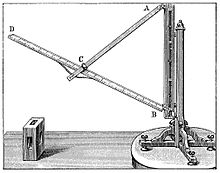- Triquetrum
-
El triquetrum —del latín tri ("tres") y quetrum ("esquinas")— era el nombre medieval de un antiguo instrumento astronómico descrito por Ptolomeo en el Almagesto empleado para determinar la altura de cuerpos celestes.
Ptolomeo lo llama "instrumento paraláctico" y parece que lo usó para determinar la distancia cenital y el paralaje de la Luna.[1]
Cumplía con la misma función que el astrolabio pero fue diseñado con el objetivo de dar los grados con mayor exactitud. Consistía en un poste vertical con una regla graduada y dos brazos pivotantes unidos por bisagras a ambos extremos, el brazo de arriba con mirilla. Los dos brazos estaban unidos entre sus extremos de manera que se estos se pudieran deslizar. Cuando el observador alineaba el objeto celeste con la mira del brazo superior el brazo inferior cambiaba su ángulo. La lectura de la medida de la regla, en combinación con la altura vertical, daba la distancia acimutal o, alternativamente, la altitud del objeto celeste.[2]
El triquetrum fue el instrumento astronómico más popular hasta la invención del telescopio, por la ventaja que tenía sobre el astrolabio a la hora de medir los ángulos. Copérnico describe su uso en el libro cuarto de De revolutionibus orbium coelestium bajo la cabecera de "Instrumenti parallactici constructio".[3] También fue usado por Tycho Brahe.[4]
Notas
- ↑ Kelley, D., Milone, E., (2005), Exploring Ancient Skies: An Encyclopedic Survey of Archaeoastronomy, pages 77-79. Birkhäuser.
- ↑ Krebs, R., (2004), Groundbreaking Scientific Experiments, Inventions, and Discoveries of the Middle Ages and the Renaissance, page 225. Greenwood Publishing Group.
- ↑ Gassendi, P., Thill, O., (2002) The Life of Copernicus (1473-1543), pages 118-120. Xulon Press.
- ↑ Christianson, J., (2000), On Tycho's Island: Tycho Brahe and His Assistants, 1570-1601, pages 73-75. Cambridge University Press.
Wikimedia foundation. 2010.

